People don’t easily settle when it comes to booking a vacation. After all, you work hard all year to go on a well deserved holiday. Whether someone is looking for an active vacation or just wants to lay next to the swimming pool, everyone wants their vacation time to be relaxed and not stressful. That’s why a lot of thinking, researching and planning goes into booking a vacation. Unfortunately, this isn’t always a smooth process. The travel industry deals with one of the worst customer satisfaction levels, as people have high expectations that aren’t always met. Plus, there are so many competitors in the travel space, so customers can easily switch to another company after one single bad experience.
When high expectations aren’t met, it is not just something for the Customer Service department to deal with. Expectations are to be set and managed correctly, and that starts at the beginning of the journey. So as a designer, analyst or marketer, you can help your customer and your colleagues by ensuring information is clear, the booking process is straightforward, expectations are maintained and customers are nurtured throughout the journey. One way to guarantee all these things are tied to what the customer wants is by gathering customer insights through their feedback. And it may be what distinguishes good travel companies from great travel companies.
Let’s take a look at how some prominent companies in the travel industry use feedback to improve the customer journey. We’ll also share some tips and tricks that we learned from these feedback cases.
- Feedback for travel agencies and booking websites
- Feedback for airlines
- What we can learn from these feedback cases
Feedback for travel agencies and booking websites
According to a study by Travelperk in the United States, there is a huge experience gap between booking a vacation and actually going on a vacation. They found that 64% of the participants really enjoyed going on vacation, but only 26% really enjoyed booking their vacation. A whopping 43% didn’t even like booking a vacation at all. The journey towards the trip needs to be made more enjoyable and convenient. However, the customer journey for booking a vacation is long and complex. With long, we mean very long. It can take months before a potential customer actually books a vacation. And with complex, we mean that customers research their vacation on multiple devices and channels at any time and any place.
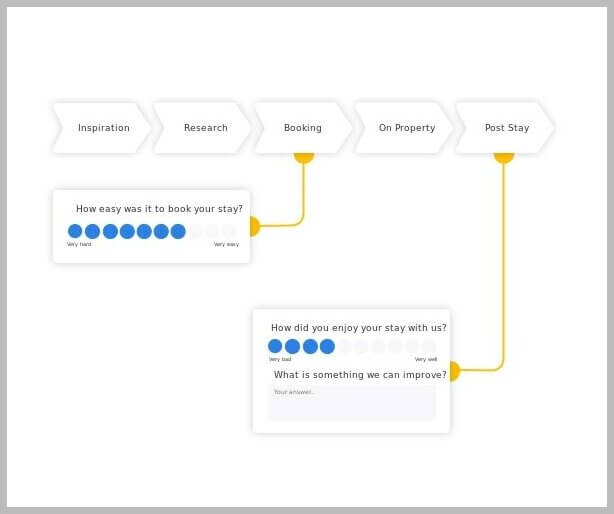
It’s difficult knowing where your customer is in the journey and what they need at each step. Customer data is very useful, but is not always available. So, the question for booking websites and travel agencies is how to ensure that customers find the information they require and book with them?
At its core, it’s all about putting your customer first. To get more insights into how your customers experience the entire booking process, from the initial research until they come back from their holiday, you need to listen to them. For many, that seems easier said than done. That was the same challenge Marvin Soekra – e-commerce Manager at de Jong Intra Vakanties – was facing.
We all say that the customer comes first, but how can you really deliver on that? With feedback from your customers, you receive valuable insights that you require in order to do just that. You don’t have to speculate, but rather you can improve the customer journey by using facts.
Marvin Soekra, E-Commerce Manager at de Jong Intra Vakanties
How De Jong Intra Vakanties uses feedback
First, they started with a goal. This step is often overlooked, but it’s very important to define a clear objective before you start collecting feedback. The goal of De Jong Intra Vakanties is to answer every question the customer has. They have a huge assortment of travel destinations and themes, so that’s quite an ambitious goal.
They already had some ideas about the problems their visitors were facing and the questions they needed to answer. But they didn’t want to rely on speculating and assumptions. Real data and facts were needed to verify their ideas. Feedback forms were deployed on different website pages to see if these problems actually existed and where these problems popped up.
They deployed feedback forms that measure the Goal Completion Rate and the Customer Effort Score. This helped them get a clear picture of whether a goal was completed and how much effort it took, or whether a goal was not completed and the reason for that. Furthermore, they collect feedback on their content as they are curious to know how customers experience their landing, themes and product pages.
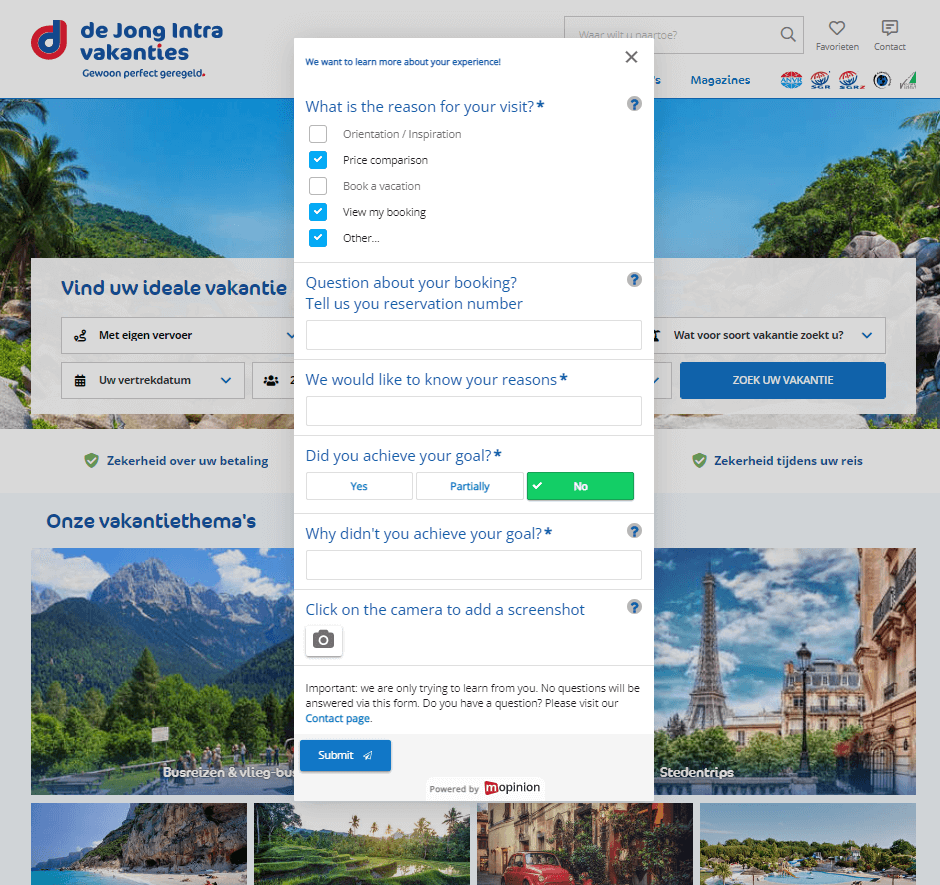
Source: De Jong Intra Vakanties
The travel industry deals with one of the highest cart abandonment rates of all industries. According to SalesCycle, 85% of desktop shoppers abandon their travel purchase, for mobile shoppers that’s even more at 91%. So understanding the reason people leave early is very useful. De Jong Intra Vakanties also wanted more insights into why people left before completing their goal. They deployed exit intent forms and asked customers why they were leaving early. Note! Marvin Soekra emphasizes that they are very conscious about when and where to ask for feedback, so that potential customers don’t get overwhelmed with questions.
All the data they collected, through the feedback forms, were used to fuel AB tests to make improvements. UX Designer Jeroen Straat gives us a great example:
“As a UX Designer, you want to make the online user experience as pleasant as possible. Customer feedback showed that there were many questions about the Payments topic. For example, it was unclear when and how to pay. Once this information was known, A/B tests were carried out and the product page now clearly states how the payment process works so that the customer knows what to expect and what it entails. Updating this page has given us increased conversions on this product page.”
As said, De Jong Intra Vakanties has a huge assortment. Feedback can be given on any kind of topic, from different holiday destinations to the purchase process. That is why Jeroen makes use of the automatic tagging in Mopinion. With its machine learning capabilities, it can recognize which feedback belongs to which topic and automatically assign a tag. It helps Jeroen go through the feedback items and find out which topics are trending and whether the sentiment is positive or negative. This makes analysing and taking action on feedback way easier. And that’s exactly what they did according to Marvin:
Thanks to feedback, we have been able to improve a number of touchpoints along the customer journey
How Luxury Escapes uses feedback
Luxury Escapes is a travel agency, most known for its special offers and discounts in luxury travel. Like other companies in this industry, they want to know who their customers are, what their customers want, and how they can meet these expectations. And they use feedback to get this done. Besides vacations, Luxury Escapes collaborates with hotels and restaurants all over the world.
Our goal is to increase customer satisfaction while also improving the quality of our partnerships.
Nathan Contin, Customer Service Team Leader at Luxury Escapes
A whole process is in place to match partners to customers. With feedback, Luxury Escapes gets a good understanding which partners fit the needs of their customers and their own offers.
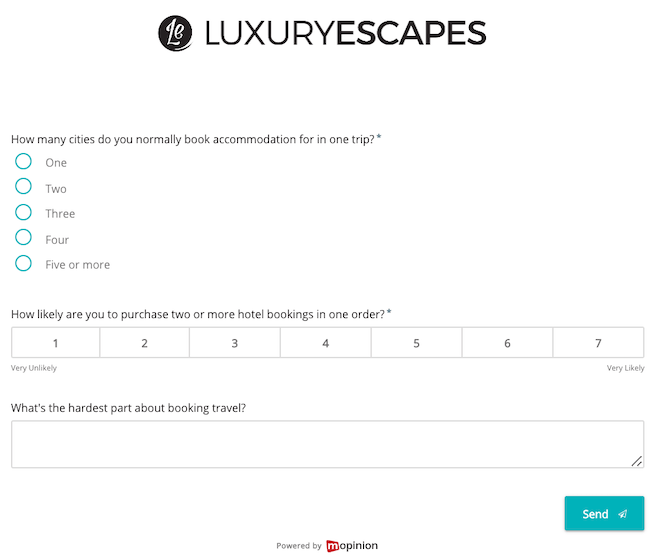
Source: Luxury Escapes
When customers come back after their vacation, they are asked about their experience with the accommodation through email feedback. Based on the feedback, Luxury Escapes evaluates the partnership with hotels and restaurants and determines whether they will move forward with them. This makes feedback an important part of the strategic processes, like Nathan explains:
“We have more than 100 partnerships with hotels and as a direct result of the customer feedback we’ve collected, we’ve made a Top 10 of locations that we definitely want to work with again next year.”
Feedback for Airlines
Feedback is not only useful for travel agencies and booking websites, who focus heavily on the online experience. Airlines also make use of feedback, often to measure the helpfulness of customer service and the provision of (real-time) travel information. Customer service and customer experience are typically intertwined in the travel industry. Let’s take a look at how airline Air France-KLM uses feedback.

How Air France-KLM uses feedback to improve their Customer Service
Air France-KLM is one of the biggest airlines in the world. They transport 77 million passengers a year, to 318 destinations all around the world. It’s safe to say that some of these passengers can have questions about their flight. Whenever they do, they can contact the customer service departments. The customer service agents are also located around the world and are therefore always available to answer any question customers have.
To aid customer service agents with offering a great service, Air France-KLM has implemented an internal knowledge system that contains all the information agents need. To keep this system up-to-date and complete, they ask their agents for feedback on the content. Every page of the system has a feedback button. Agents can provide or request complementary information for the content, which is then reviewed by the service department.
Mopinion enables our customer service agents to improve the quality of our internal Knowledge Management system, leading to a better customer service.
What we can learn from these feedback cases
There are many lessons to be learned from how De Jong Intra Vakanties, Luxury Escapes and Air France-KLM have achieved success with feedback. There are many other travel customers who also make great use of feedback. We put together a list of learnings.
Take advantage of standard CX metrics
The first thing that we want to emphasize is that feedback helps you measure customer satisfaction and customer loyalty in standard measurements. As part of your customer experience strategy or Voice of Customer program it can help you keep a finger on the pulse when it comes to listening to your customers. This can be done by measuring CSAT, NPS or GCR on multiple touchpoints. When measuring this consistently over time, you can easily notice changes in real-time and make improvements quickly. But don’t just compare this over time, you can also compare different variables such as the country, persona, age, and much more. See the screenshots below for some examples of how you can keep track of these data points.
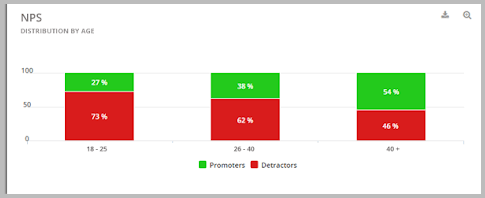
NPS over time per travel persona

NPS distribution per age group
Group feedback to make analysing easier
Analysing feedback is just as important as collecting it. There are several ways to make analysing feedback easier. In the travel industry, there are many topics a customer can have a question about or form an opinion about. So when asking for feedback, you need to know what topic they are referring to. This can be done by asking your customer what topic they want to give feedback on. Determine the topics upfront and let them select the right topic in the form. Do this with either a dropdown menu or clickable buttons.
Clustering can also be done by making use of tags within your feedback inbox and dashboard. You can add tags to feedback items. For example, you can add the word “purchase” to feedback items about the purchasing process. Use the automatic tagging to let Mopinion add tags to your feedback items. This makes dealing with large numbers of feedback way more doable and helps you determine which topics to focus improvements on.
Customer service can benefit from feedback too
The provision of information in the travel industry is very important, customers don’t want to be late to their flight or find out they are missing specific documents. Customers want to know what they can expect and need detailed information about their tickets, luggage, accommodation, terms, and much more in real-time. Therefore, it’s important to measure whether the information provided is helpful and can easily be found. One example of how to improve the information provision is by asking feedback on an FAQ page.
Here we see an example of Roompot, known for its holiday parks, collecting feedback on their FAQ page. On each question and answer item, they ask whether the information was helpful. This helps the customer service department in two ways. First, customers find the ‘helpful’ answer to their question on the website and don’t need to contact customer service. Second, when there are many questions at customer service about a certain topic, they can turn it into an item in the FAQ. So not only does feedback improve the information provision, it also helps customer service lower the workload.
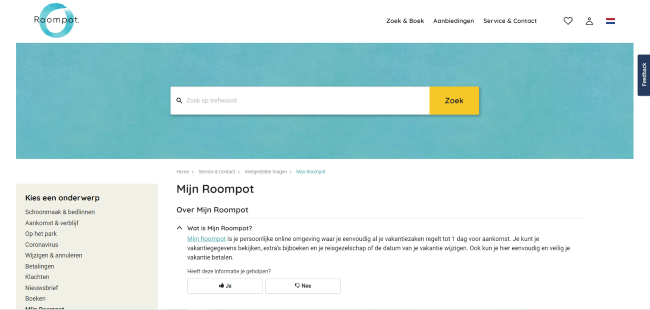
Source: Roompot
Another example is email feedback. We all know how many emails you receive after booking a flight or holiday filled with information and documents. Too much information can be distracting them from the most important parts, but too little information can be troublesome. Make sure your customers have the right information available at the right time. Measure how useful the information in each email is and see whether you can make improvements.
App feedback can really improve your travel app
Let’s not forget that mobile usage is still growing to this day. In 2021, 60% of the online traffic in the travel industry came from mobile traffic, up from 38% in 2020. More and more travel companies have an app and want to provide their users with a great experience there as well. That’s why we see a rise in the use of app feedback, as it’s how companies can ensure a smooth journey on the app. Understanding the needs of app users is just as important as it is on the desktop. We recommend collecting feedback on this channel as well.
Use feedback to fuel your A/B tests
De Jong intra uses feedback as input for A/B-tests on their website. When a page has a low GCR or CES, they perform an A/B-test on the page to improve it. For them, this has resulted in higher conversion rates. We definitely recommend using feedback to discover where and what you need to experiment with. Fun fact: You can use Mopinion to do A/B-tests or to improve your AB tests. There are 2 ways to do this:
- Collect feedback on both pages of your A/B-test and compare the feedback to see which one offers a better user experience (in addition to your quantitative data research).
- Test two different feedback forms and see which one receives more responses.
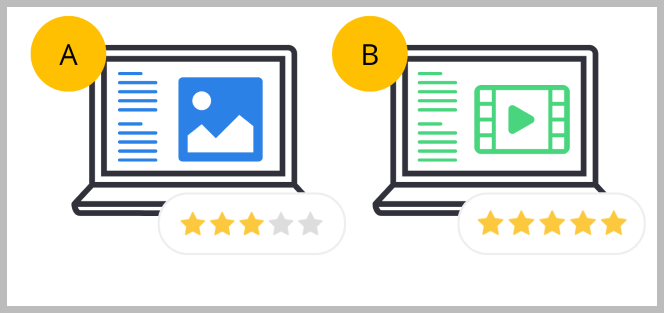
No need to be overwhelming
As said by Marvin Soekra from De Jong Intra vakanties, they are conscious about where and when they ask for feedback. Researching and planning a vacation can be quite overwhelming, so you don’t want to bombard your customers with questions. Various techniques should be used to collect the most useful information without distracting the customer from their initial goal. For example, by triggering feedback forms based on visitor behavior or based on previous purchases, you make asking for feedback relevant for the customer as well. A passive feedback button can also help avoid overwhelming your customers because they can give feedback on their own terms.
Conclusion
Collecting feedback and putting it into action is a great way to improve the CX. And that’s especially important in the travel industry where there are many competitors and high customer demands. We see travel companies adopting feedback in various ways. We recommend looking at what works best for your company, but keeping these learnings in mind.
Ready to see Mopinion in action?
Want to learn more about Mopinion’s all-in-1 user feedback platform? Don’t be shy and take our software for a spin! Do you prefer it a bit more personal? Just book a demo. One of our feedback pro’s will guide you through the software and answer any questions you may have.








